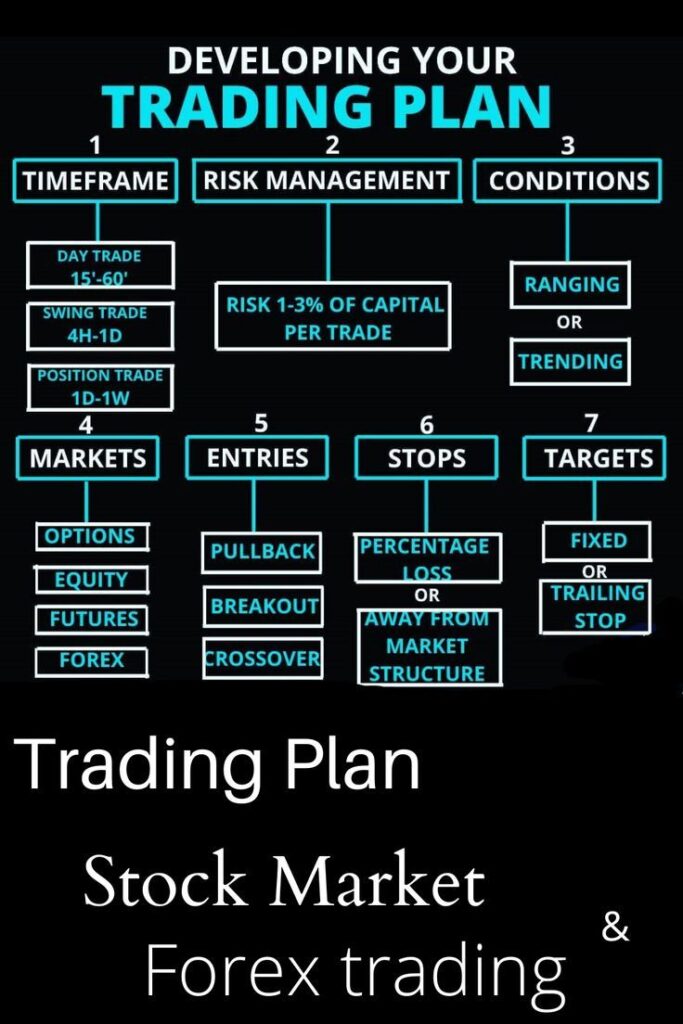Introduction
Trading without a plan is like sailing without a compass. Many traders enter the market with excitement but without direction, often leading to inconsistent results and emotional decisions. A trading plan acts as a structured guide, providing clear rules for when to enter, manage, and exit trades.
In this article, we’ll explore what a trading plan is, why it’s crucial, what it should include, and how to build one that aligns with your trading goals and personality.
What is a Trading Plan?
A trading plan is a comprehensive document that outlines a trader’s strategies, risk management rules, and personal goals. It removes guesswork and emotion from the decision-making process by defining clear actions for every trading scenario.
The plan includes:
- Entry and exit criteria
- Risk and money management rules
- Timeframes and instruments to trade
- Psychological preparation and discipline techniques
A trading plan is personalized—what works for one trader may not suit another.
Why Every Trader Needs a Trading Plan
- Consistency
A plan helps you make decisions based on logic and predefined rules, not emotion or impulse. - Accountability
It allows you to track performance and understand whether your losses came from bad execution or bad strategy. - Improved Risk Management
Plans define how much to risk per trade, preventing overexposure. - Confidence
Knowing your rules in advance helps reduce anxiety during market fluctuations. - Adaptability
A plan can evolve with your experience, allowing you to refine your approach over time.
Key Components of a Trading Plan
1. Trading Goals
Define both short-term and long-term goals.
Examples:
- Grow account by 5% per month
- Achieve consistency over 6 months before increasing risk
- Limit drawdown to no more than 10%
Goals should be realistic, measurable, and time-bound.
2. Market Selection
Specify which assets or markets you will trade, such as:
- Forex (EUR/USD, GBP/USD)
- Stocks (Apple, Tesla)
- Commodities (Gold, Oil)
- Crypto (Bitcoin, Ethereum)
Stick to a few instruments you can understand and monitor closely.
3. Trading Timeframe
Choose the timeframe(s) that suit your lifestyle and trading style:
- Scalping: 1-min to 5-min
- Day Trading: 15-min to 1-hour
- Swing Trading: 4-hour to daily
- Position Trading: Daily to weekly
Your plan should match your availability and psychological comfort.
4. Strategy and Entry Rules
Define exactly how you’ll enter a trade:
- Technical indicators (e.g., RSI, MACD, moving averages)
- Chart patterns (e.g., head and shoulders, trendlines)
- Candlestick patterns (e.g., pin bars, engulfing candles)
- Fundamental signals (e.g., news releases, earnings reports)
Include screenshots or diagrams if needed.
5. Exit Rules
A trade is only complete when it’s closed. Your plan should state:
- Where to place your stop-loss
- How to set your take-profit
- Rules for early exit (e.g., pattern break, news release)
Avoid emotional exits—stick to your predefined rules.
6. Risk Management
Decide in advance:
- How much to risk per trade (e.g., 1-2% of account)
- Maximum daily and weekly loss limits
- Maximum number of trades per day
Risk management protects your capital more than any strategy.
7. Position Sizing Formula
Your plan should include how to calculate trade size.
Example formula:
Position size = Risk amount / (Stop loss in pips × pip value)
This ensures that risk remains consistent regardless of trade size.
8. Trading Journal
Track every trade including:
- Entry and exit points
- Reasons for the trade
- Mistakes or emotional decisions
- Result (profit/loss)
- Screenshot of the chart
A journal reveals patterns in your behavior and areas to improve.
9. Psychological Preparation
Include ways to maintain discipline:
- Pre-trading routine (review charts, read plan)
- Avoid trading when emotional, tired, or distracted
- Use affirmations or breathing techniques if needed
Your mindset is just as important as your strategy.
How to Create Your Own Trading Plan
- Write It Down: Use a digital document or printable template. Don’t keep it in your head.
- Start Simple: Avoid overcomplicating. Your plan should be clear and executable.
- Test Your Plan: Use demo or backtesting to ensure the strategy is valid.
- Follow It Strictly: Treat your plan as law—only change it based on tested improvements, not feelings.
- Review Weekly or Monthly: Evaluate performance and refine the plan as needed.
Common Mistakes to Avoid
- Trading without a plan
- Changing rules in the middle of trades
- Ignoring stop-loss or risk rules
- Trading too many assets
- Letting emotions override your system
- Failing to review and improve
Conclusion
A trading plan is not optional—it’s essential for any trader aiming for long-term success. It creates structure, promotes discipline, and enables consistent decision-making.
Remember, trading is a business, not a game. Professionals don’t rely on luck; they rely on systems. Building and following a solid trading plan is the first step toward becoming a consistent and profitable trader.


